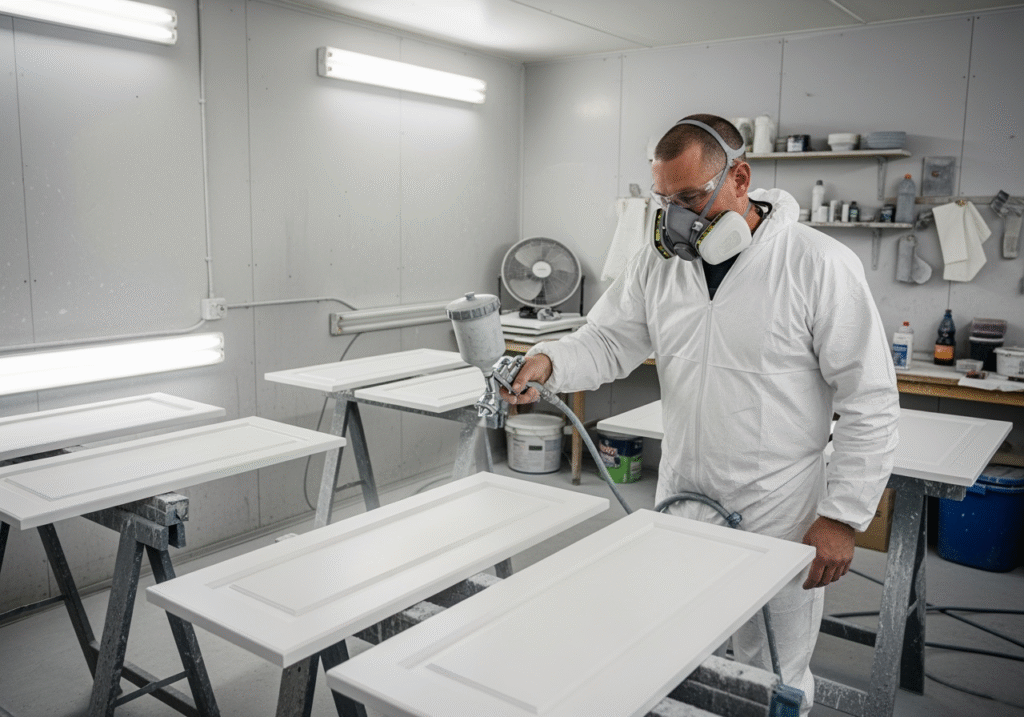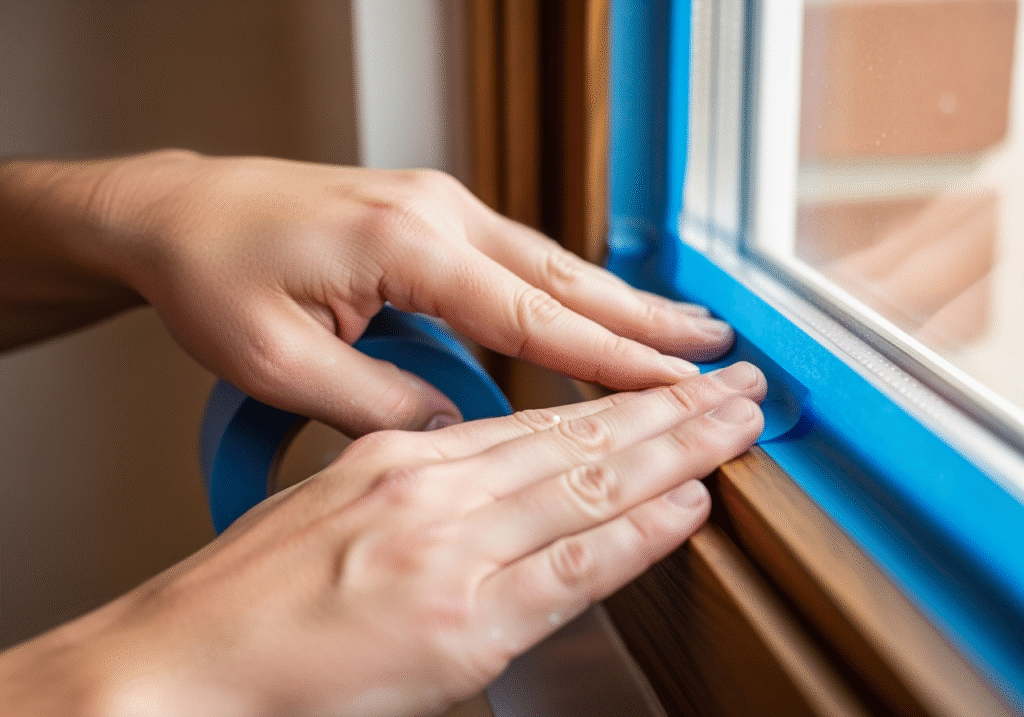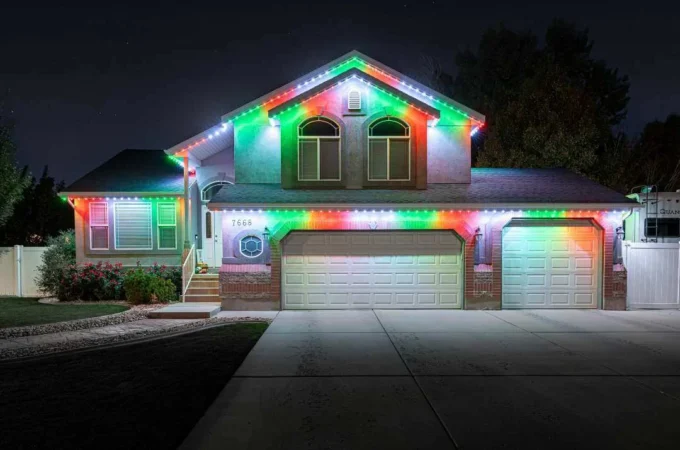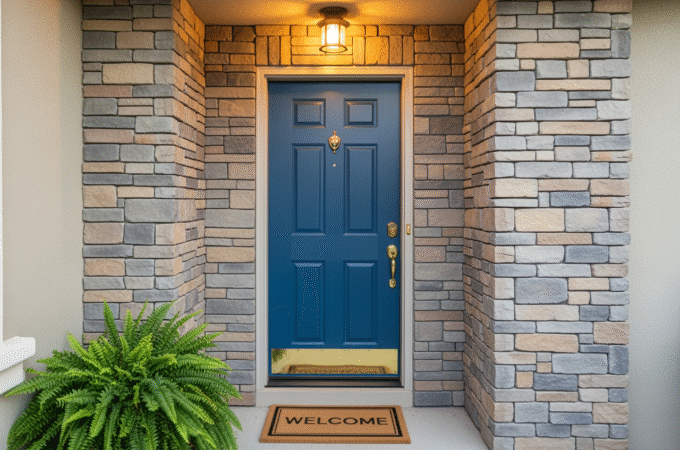
7 Questions to Ask Before Hiring a House Painter
Table of Contents
ToggleWhat Is Your Experience and Full Range of Services?
A fresh coat of paint can truly transform a home. Imagine walking into a bright, freshly painted living room with neat trim work that makes the whole space feel new. Paint does more than just change a color. It protects your home and can even increase its value.
Hiring the right house painter is a big step. It ensures your project’s success. Professional painting offers clear benefits over doing it yourself. These include saving time, superior quality, safety, and increased home value.
But how do you choose the best painter for your needs? This guide will help you. We will share seven key questions before hiring a house painter. These questions will help you find a reliable, skilled professional. They will ensure your painting project goes smoothly from start to finish.
Understanding a potential painter’s experience and the breadth of their services is paramount when starting a painting project. This initial inquiry helps us match their skills to our specific project needs. It ensures we vet a contractor capable of delivering the desired outcome, whether refreshing a single room or undertaking a complete exterior overhaul. The scope of work dictates the expertise required.

Professional painters offer diverse services beyond just applying paint to walls. These can include specialized tasks like cabinet painting, which requires meticulous preparation and application techniques to achieve a smooth, durable finish. For instance, many professional services excel at changing kitchen cabinets, often involving removal, off-site spraying, and careful reinstallation to ensure a factory-like quality. You can find examples of the comprehensive services offered by various reputable painting companies, including detailed descriptions of their processes, by exploring their online portfolios or customer reviews on multiple platforms.
Differentiating Between Interior and Exterior Projects
Interior and exterior painting, while both involving paint application, are fundamentally different and require distinct expertise.
Interior Painting focuses on enhancing the aesthetic appeal and atmosphere of living spaces. Considerations include:
- Surface Types: Drywall, plaster, wood trim, ceilings, and various types of cabinetry. Each demands specific primers and paint types for optimal adhesion and finish.
- Air Quality: Using low-VOC (volatile organic compound) paints is increasingly essential for indoor environments, promoting better health for occupants and painters alike. This growing demand for eco-friendly and low-VOC paints is a significant trend, with a substantial portion of consumers prioritizing these options for health and environmental reasons.
- Durability: Interior paints must withstand daily wear and tear, scuffs, and cleaning, so durability and washability are key.
Exterior Painting, on the other hand, is primarily about protection and curb appeal. The challenges and requirements are unique:
- Weather Resistance: Exterior paints must endure harsh weather conditions, including rain, humidity, UV radiation, and temperature fluctuations. They act as a crucial barrier against moisture, preventing rot and structural damage.
- UV Protection: Paints with good UV resistance prevent fading and chalking, maintaining the home’s vibrant appearance for longer.
- Surface Types: Siding (wood, vinyl, fiber cement), stucco, brick, trim, decks, and fences have different absorption rates and require specialized paints and preparation.
- Preparation: Thorough cleaning, scraping loose paint, repairing damaged surfaces, and proper priming are critical for longevity.
Understanding a Painter’s Local Experience and Specializations
A painter’s experience in your specific geographic area can be incredibly valuable. Local climate, common architectural styles, and regional building codes can influence the best painting practices and material choices. For instance, a Baldwin County house painter service will have crucial expertise in handling high humidity and salt air, a significant advantage for coastal homes. Their knowledge of how these environmental factors affect paint adhesion, drying times, and long-term durability is indispensable.
When interviewing painters, ask about:
- Years in Business: A long-standing presence often indicates reliability and a proven track record.
- Portfolio Review: Ask to see examples of similar projects they’ve completed. This provides tangible evidence of their quality and style.
- Customer Testimonials: Reputable painters will gladly provide references or direct you to online reviews. Look for consistent praise regarding professionalism, quality, and adherence to timelines.
- Specializations: Some painters specialize in historic homes, requiring a delicate touch and knowledge of period-appropriate techniques and materials. Others might focus on commercial properties, understanding the need for flexible work hours to minimize business disruption. Many painters highlight their specialized approach to different painting needs, from interior aesthetics to exterior protection.
By delving into a painter’s experience and service range, we gain confidence that they possess the necessary skills and understanding to tackle our project effectively, ensuring a high-quality and lasting result.
Can You Detail Your Painting Process from Start to Finish?
A professional painting service isn’t just about applying paint; it’s about following a meticulous, structured process that ensures a high-quality, durable finish and protects your property. Asking a potential painter to detail their process from start to finish is a key indicator of their professionalism and attention to detail. It helps us understand what to expect at every stage, from initial preparation to final cleanup.
A well-defined process demonstrates that the painter is organized, experienced, and committed to delivering excellent results. It also provides transparency, allowing us to anticipate timelines, understand the steps involved, and feel confident that no crucial steps will be overlooked. Reputable services often provide comprehensive outlines of their approach, similar to the detailed guides on home improvement platforms, emphasizing thoroughness from start to finish.

The Critical Role of Preparation and Property Protection
Preparation is arguably the most crucial phase of any painting project. Without proper surface preparation, even the highest quality paint will fail prematurely. A professional painter will typically outline the following steps:
- Surface Cleaning: Walls, trim, and ceilings are thoroughly cleaned to remove dirt, dust, grease, and grime. This often involves power washing to remove mildew, loose paint, and debris for exterior projects.
- Sanding and Scraping: Loose or peeling paint is scraped away, and surfaces are sanded smooth to ensure proper adhesion of new paint. This step is vital for a uniform and long-lasting finish.
- Priming: A suitable primer is applied, especially over patched areas, new drywall, or surfaces with significant color changes. Primer helps with adhesion, provides a uniform base, and can block stains.
- Filling Holes and Caulking Cracks: All nail holes, dents, and minor imperfections are filled with spackle or wood filler and sanded smooth. Cracks in trim, baseboards, windows, and doors are caulked to create a seamless look and seal out moisture.
- Property Protection: This involves carefully covering all areas not to be painted. Drop cloths are laid down to protect floors and furniture. Plastic sheeting covers larger items, light fixtures, and countertops. Exterior projects require careful masking of windows, doors, and landscaping. This diligent protection ensures that paint only goes where intended, and your belongings remain pristine.
Application Techniques for a Flawless Finish
Once preparation is complete, the focus shifts to paint application. A professional painter will employ techniques that ensure a smooth, even, and durable finish:
- Brushing and Rolling: For interior walls, professional painters typically use rollers for large, flat surfaces and brushes for cutting in around edges, trim, and corners. This combination allows for efficient coverage and precise lines.
- Airless Spraying: For large exterior surfaces, fences, or cabinet doors, airless spraying can provide a remarkably smooth and uniform finish, free of brush strokes. However, this method requires significant skill and extensive masking to prevent overspray.
- Number of Coats: Most professional jobs involve applying at least two coats of paint. The first coat provides initial coverage, while the second ensures full opacity, color richness, and improved durability. As noted by many experts, including those discussing exterior painting best practices, two coats can significantly extend the paint’s lifespan and may even be required for manufacturer warranties.
- Quality Paint Products: Professionals typically recommend and use high-quality paints from reputable brands. These paints offer superior coverage, durability, and a better finish than cheaper alternatives.
- Sharp Cut-in Lines: A hallmark of professional painting is crisp, straight lines where different colors meet, such as between walls and trim or ceiling. This “cutting in” is often done freehand by skilled painters, rather than relying solely on painter’s tape, for a seamless transition.
- Final Walkthrough and Cleanup: Upon completion, a thorough inspection is conducted with the homeowner to ensure satisfaction. Any necessary touch-ups are made. Finally, all equipment is removed, and the work area is carefully cleaned, leaving your home spotless and beautifully painted. This comprehensive approach sets professional house painter services apart, from the initial setup to the final inspection.
How Do You Determine Costs and What’s in the Quote?
Understanding the cost structure and what is included in a painter’s quote is crucial for avoiding hidden fees and ensuring financial transparency. A reputable house painter will provide a detailed, written estimate that outlines all charges. This allows us to compare bids effectively and make an informed decision.
A vague quote, often just a single number, can lead to misunderstandings and unexpected costs down the line. In contrast, a detailed quote breaks down the project into specific line items, giving us a clear picture of what we’re paying for.
A professional house painter service is an investment in your home’s longevity and aesthetic appeal. Choosing the right one means asking insightful questions and understanding the value they bring.
Key Factors That Influence the Cost of a House Painter Service
Several elements contribute to the overall cost of a house painting project. Understanding these factors can help us interpret quotes and manage our budget effectively.
- Project Size: This is typically measured in square footage. Larger homes or extensive areas naturally require more paint and labor, increasing costs. For example, in 2023, the average price of hiring a professional painter in the US was around $500 to $1,000 for a single room, with larger projects like painting an entire house costing between $3,000 and $6,000.
- Surface Condition: The amount of preparation needed significantly impacts the price. Surfaces with peeling paint, cracks, holes, or mildew require more labor for scraping, sanding, patching, and cleaning. Extensive repairs, such as significant drywall work or wood rot replacement, will add to the cost.
- Accessibility: Homes with multiple stories, intricate architectural details, or difficult-to-reach areas (e.g., high ceilings, narrow hallways, complex trim work) may require specialized equipment like scaffolding or lifts, and more time, leading to higher costs.
- Number of Colors: Painting with multiple colors, especially if they require precise cutting-in or intricate designs, increases labor time.
- Paint Finish (Matte, Satin, Gloss):Different finishes have varying costs. Higher gloss paints, for instance, often require more meticulous surface preparation to look flawless.
- Type and Quality of Paint: Premium paints, while more expensive upfront, offer better coverage, durability, and a longer lifespan, potentially saving money in the long run. Professional painters often recommend specific brands, like those discussed in industry guides, because of their proven performance and warranty backing.
- Necessary Repairs: The total will include any underlying issues, such as water damage, extensive drywall repair, or carpentry work, that need to be addressed before painting.
A transparent quote will detail these elements, clearly separating labor, materials, and additional services. This level of detail empowers us to make informed decisions and ensures no surprises when the final bill arrives.
What Are Your Credentials and Guarantees?
When entrusting our home to a painting service, verifying their credentials and understanding their guarantees is paramount. These elements protect us, the homeowners, and are non-negotiables for a legitimate and reliable contractor. This inquiry helps us ensure the painter is skilled and operates with integrity and accountability.

Why Insurance and Licensing Are Essential
The importance of an adequately insured and licensed painter cannot be overstated. These are fundamental protections for both parties:
- General Liability Insurance: This covers damage to your property caused by the painting crew. If a painter accidentally spills paint on your new carpet or damages a fixture, their liability insurance should cover the cost of repair or replacement. Without it, you could be left to bear the financial burden.
- Workers’ Compensation: If a painter or their employee is injured on your property, Workers’ Compensation insurance covers their medical expenses and lost wages. Without this, as the homeowner, you could be liable for their injuries, leading to significant financial and legal complications.
- Property Damage Protection: Beyond direct damage, this aspect of insurance ensures that any unintended consequences of the work are covered.
- Legal Recourse: Working with a licensed contractor provides legal protection. Licensing often means the contractor has met specific state or local skill, knowledge, and ethical business practices requirements. In case of disputes, you have established channels for resolution.
- Contractor Legitimacy: Proper insurance and licensing indicate a legitimate, professional business that takes its responsibilities seriously. Many platforms that connect homeowners with professionals require their listed contractors to carry substantial liability insurance and WSIB (Workers’ Compensation) coverage.
Always ask for proof of insurance and licensing, and verify their validity.
Understanding Warranties for a House Painter Service
A reliable painting company stands behind its work with clear warranties. This commitment provides peace of mind and protection against premature paint failure.
- Workmanship Guarantee/Labor Warranty: This warranty covers the quality of the application. If the paint starts to peel, chip, or bubble due to faulty preparation or application within a specified period, the painter should rectify the issue at no additional cost. These warranties typically range from one to five years, though some premium services may offer longer durations. For instance, as highlighted in discussions about painting warranties, some companies provide guarantees on labor for several years, often contingent on proper application (e.g., two coats).
- Paint Manufacturer Warranty: The paint itself comes with a warranty from the manufacturer, covering defects in the product. This is separate from the labor warranty and typically covers issues like fading, chalking, or blistering due to the paint’s formulation, not the application. High-quality paints often come with warranties spanning many years, sometimes even decades.
- What is Covered: Ensure you understand what specific issues are covered (e.g., peeling, blistering, fading) and what is excluded (e.g., normal wear and tear, damage from external forces like impact or severe weather).
- Warranty Duration: Note the length of both the labor and manufacturer warranties. More extended warranties typically indicate greater confidence in their materials and craftsmanship.
- Written Documentation: Always insist on receiving all warranty information in writing, clearly stating the terms, conditions, and duration. This written record is your protection should any issues arise after completing the project.
By thoroughly checking credentials and understanding guarantees, we ensure that our investment is protected and that we work with a professional committed to long-term satisfaction. Our commitment to quality and customer satisfaction is a core part of our philosophy, and we believe in providing thorough information on all aspects of our services, including our home renovation services in Foley, Alabama, to ensure client confidence.
Frequently Asked Questions about House Painter Services
Beyond the initial questions about experience, process, and credentials, homeowners often have practical inquiries about managing their painting project. Here, we address some common questions to help you prepare and make the most of your professional painting service.
What are the signs that my home needs repainting?
Recognizing the signs that your home needs a fresh coat of paint, both inside and out, can help us maintain its appearance and protect its structural integrity. A survey found that 75% of homeowners believe that a fresh coat of paint significantly improves the perceived value of their home, underscoring its importance.
Exterior Signs:
- Peeling or Flaking Paint: This is the most obvious sign. Once paint starts to peel, it loses its protective qualities, exposing the underlying material to the elements.
- Cracking and Bubbling: These indicate a loss of adhesion, often due to moisture issues or extreme temperature fluctuations.
- Fading Color: Exposure to UV rays causes paint to fade over time, making your home look dull and dated.
- Chalking Residue: When you run your hand across the surface, a powdery residue comes off, and the paint breaks down.
- Hardened Caulk: Caulk around windows and doors can dry out, crack, and pull away, creating gaps that allow moisture intrusion.
- Visible Mold or Mildew: Dark spots on the exterior indicate moisture problems that must be addressed before repainting.
Interior Signs:
- Fading or Discoloration: High-traffic areas or rooms exposed to sunlight can show noticeable fading or yellowing.
- Scuffs, Marks, and Dings: Everyday wear and tear can leave numerous imperfections that a fresh coat can easily cover.
- Outdated Colors: Repainting can modernize your space if your interior colors no longer match your style or the current aesthetic trends.
- Difficulty Cleaning: If walls are hard to clean or marks won’t come off, the paint may be too old or porous.
- Selling Your Home: A fresh interior paint job is one of the most cost-effective ways to boost appeal and value before listing.
For more detailed insights on recognizing these signs and the benefits of timely repainting, many professional painters often provide comprehensive guides in their FAQ sections.
How should I prepare my home before the painters arrive?
While professional painters handle much of the preparation, a little effort from us, the homeowners, can significantly streamline the process and ensure a smoother experience.
- Declutter Rooms: Remove small items, knick-knacks, and electronics from shelves, tables, and walls.
- Remove Wall Decor: Take down all pictures, mirrors, and wall hangings. Remove any nails or screws unless specifically instructed otherwise by the painter (they may prefer to handle nail hole filling).
- Secure Pets: Arrange for pets to be kept in a safe, contained area away from the work zone, or consider boarding them for the project’s duration, especially during interior painting.
- Clear Access Paths: Ensure pathways to and around the areas to be painted are clear of obstacles.
- Discuss Furniture Moving Plan: While many painters will move larger furniture, discuss this beforehand. Some homeowners prefer to move smaller, more fragile items themselves. Ensure there’s a clear plan for protecting or moving heavier pieces.
- Clean Surfaces (Lightly): Lightly dusting or wiping surfaces can help, but professional painters will typically do a more thorough cleaning as part of their prep work.
- Inform About Sensitive Items: Point out any delicate or irreplaceable items that require extra care, even if they are not directly in the work area.
By taking these proactive steps, we help the painters start their work efficiently, minimizing delays and ensuring the focus remains on delivering a beautiful finish.
Why do professionals recommend specific paint brands or types?
Professional painters don’t just pick paints randomly; their recommendations are based on years of experience and a deep understanding of paint chemistry and performance. They often recommend specific brands or types for several compelling reasons:
- Durability and Longevity: High-quality paints from reputable brands are formulated to last longer, resist fading, cracking, and peeling, and withstand cleaning better. This means your paint job will look good for many years, providing a better return on your investment.
- Finish Quality: Premium paints offer superior coverage and a smoother, more uniform finish. They often have better leveling properties, reducing brush marks and roller textures.
- Superior Coverage: Better paints typically offer higher pigment concentration, meaning they can cover existing colors more effectively, often requiring fewer coats. This saves time and labor.
- Low-VOC Options for Health: As mentioned earlier, the demand for eco-friendly and low-VOC paints is increasing. Professionals are well-versed in brands that offer these healthier alternatives without compromising performance, ensuring better indoor air quality for your family.
- Suitability for the Surface: Different surfaces (e.g., drywall, wood, metal, stucco, and bathrooms) require specific paint types. For instance, bathrooms and wet areas benefit from mold-resistant paints. Exterior surfaces need paints designed to withstand particular weather conditions. Professionals know which paint is best for each application. For example, modern water-based acrylic paints are often recommended for exteriors due to their durability and environmental benefits.
- Warranty and Support: Reputable paint brands offer warranties on their products, and professional painters are familiar with these terms, providing an additional layer of assurance.
While professional painters may have their preferred brands (like Sherwin-Williams or Benjamin Moore, often cited for their quality), their ultimate goal is to select the best product for your specific project, ensuring a beautiful, long-lasting result that meets your needs and expectations.
Choosing the exemplary house painter service is a significant decision that impacts your home’s appearance and protection for years. By asking these key questions, we empower ourselves to make an informed choice, ensuring that our painting project is handled by skilled, reliable professionals who deliver exceptional results.
Ready to transform your home? Contact us today to discuss your painting needs and bring your vision to life. We offer comprehensive home renovation services and can assist with everything from kitchen and bathroom remodels to specialized painting projects.






